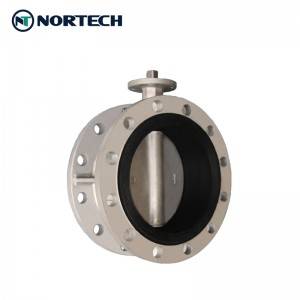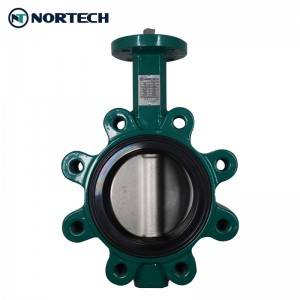1 Overview
The butterfly valve is an important device in the water supply and drainage pipeline system. With the advancement of industrial technology, different requirements are put forward on the structure and performance of the butterfly valve. Therefore, the type, material and connection form should be reasonably selected according to the working conditions during the design and selection.
The butterfly valve is an important device in the water supply and drainage pipeline system. With the advancement of industrial technology, different requirements are put forward on the structure and performance of the butterfly valve. Therefore, the type, material and connection form should be reasonably selected according to the working conditions during the design and selection.
2 Design
2.1 Structure
The closing piece (butterfly plate) of the butterfly valve is in the middle of the medium, and its influence on the flow resistance should be considered in the design.
2.1 Structure
The closing piece (butterfly plate) of the butterfly valve is in the middle of the medium, and its influence on the flow resistance should be considered in the design.
Regarding the structure of the butterfly plate of the large-diameter butterfly valve, AWWA C504 (American Water Supply Engineering Association Standard) stipulates that the butterfly plate should not have transverse ribs, and its thickness should not be greater than 2.25 times the diameter of the valve stem.
The water-incoming surface and the water-out surface of the butterfly plate should be streamlined.
The internal screws can not protrude outside the butterfly plate, so as not to increase the water-facing area.
2.2 Rubber seal
The water-incoming surface and the water-out surface of the butterfly plate should be streamlined.
The internal screws can not protrude outside the butterfly plate, so as not to increase the water-facing area.
2.2 Rubber seal
Sometimes the service life of the rubber butterfly valve is short, which is related to the rubber quality and the width of the sealing surface. The sealing ring of the rubber-sealed butterfly valve should be made of high-quality rubber materials, and the process regulations should be followed during compression molding. The vulcanization temperature should not be arbitrarily increased, and the time can be shortened, otherwise it will easily cause the sealing ring to age and crack. The metal sealing surface matched with the rubber sealing ring should have enough width, otherwise the rubber sealing ring is not easy to be embedded. In addition, the shape and position tolerance, symmetry, precision, smoothness, and elasticity of the sealing ring of the valve body and the butterfly plate also affect the service life of the rubber sealing ring.
2.2 Stiffness
Stiffness is an important issue in the design of butterfly valves, which is related to factors such as butterfly plates, valve shafts and connections.
Stiffness is an important issue in the design of butterfly valves, which is related to factors such as butterfly plates, valve shafts and connections.
(1) Valve shaft size The valve shaft size is specified in AWWA C504. If the size of the valve shaft does not meet the requirements, there may be insufficient rigidity, reverse seal leakage, and large opening torque. The stiffness of the shaft is related to 1/EI, that is to say, to improve the stiffness and reduce the deformation problem, we should start by increasing the EI. E is the modulus of elasticity. Generally, the difference of steel is not big, and the selected material has little effect on the stiffness. I is the moment of inertia and is related to the section size of the shaft. The size of the valve shaft is generally calculated according to the combination of bending and torsion. It is not only related to the torque, but also mainly related to the bending moment. In particular, the bending moment of the large-diameter butterfly valve is much larger than the torque.
(2) Shaft hole coordination The old version of AWWA C504 stipulates that the butterfly valve shaft is a straight shaft. After the 1980 version, it was proposed that it could be made into two short shafts. According to AWWA C504 and GB12238, the embedded length of shaft and hole should be 1.5d. The gap (C value) between the edge of the valve body and the support end of the butterfly plate in the axial dimension of the Japanese butterfly valve is specified, which is generally related to the size of the diameter, which is between 25 and 45mm, which is to minimize the distance between the shaft supports ( C value), thereby reducing the bending moment and deformation of the shaft.
(3) Butterfly plate structure The structure of the butterfly plate has a direct relationship with the rigidity, so in addition to the flat plate shape, it is mostly made into a pot shape or a truss shape. In short, it is to increase the moment of inertia of the section to increase the rigidity.
(4) Valve body structure There are also stiffness problems in the design of the large-diameter butterfly valve body. Generally, there are ring ribs and cross ribs. In fact, the cross ribs only increase the stability and should not be too much. The main ones are ring ribs. If you can add ∩-shaped ribs, it will be more beneficial to the rigidity, but there is a problem of poor manufacturability.
2.3 Self-lubricating bearings
Most or all of the medium pressure on the butterfly plate (reverse) is transmitted to the bearing through the shaft, so the bearing plays a very important role. Some foreign butterfly valves are light and handy, and small-caliber valves can be turned with one finger, while some domestic butterfly valves are heavy. In addition to the coaxiality, symmetry, processing accuracy, finish and the quality of the packing, it is very An important factor is the lubricity of the sleeve material. The AWWA C504 standard proposes that the shaft sleeve or bearing installed in the valve body should be self-lubricating material, and the shaft sleeve has the problem of friction reduction and lubrication, and corrosion is not allowed. Without the shaft sleeve, even if the valve shaft is stainless steel, the valve body has rust and adhesion problems. The use of bushings can also increase rigidity.
Most or all of the medium pressure on the butterfly plate (reverse) is transmitted to the bearing through the shaft, so the bearing plays a very important role. Some foreign butterfly valves are light and handy, and small-caliber valves can be turned with one finger, while some domestic butterfly valves are heavy. In addition to the coaxiality, symmetry, processing accuracy, finish and the quality of the packing, it is very An important factor is the lubricity of the sleeve material. The AWWA C504 standard proposes that the shaft sleeve or bearing installed in the valve body should be self-lubricating material, and the shaft sleeve has the problem of friction reduction and lubrication, and corrosion is not allowed. Without the shaft sleeve, even if the valve shaft is stainless steel, the valve body has rust and adhesion problems. The use of bushings can also increase rigidity.
2.4 Connection of shaft and butterfly plate
The shaft and the butterfly plate of the small-diameter butterfly valve are preferably connected by key or spline, and the polygonal shaft connection or pin connection can also be used. The shaft and the butterfly plate of the large-diameter butterfly valve are mostly connected by keys or taper pins. At present, more shafts and discs are connected by pins. The connecting pin is damaged under severe working conditions. This is mainly due to manufacturing reasons. Among them, the accuracy of the anastomosis is not good, the size of the pin is inappropriate, the hardness of the pin is not enough or the material is not suitable, etc., should be paid attention to. The shaft and the butterfly plate of the large butterfly valve can be connected by a special method.
The shaft and the butterfly plate of the small-diameter butterfly valve are preferably connected by key or spline, and the polygonal shaft connection or pin connection can also be used. The shaft and the butterfly plate of the large-diameter butterfly valve are mostly connected by keys or taper pins. At present, more shafts and discs are connected by pins. The connecting pin is damaged under severe working conditions. This is mainly due to manufacturing reasons. Among them, the accuracy of the anastomosis is not good, the size of the pin is inappropriate, the hardness of the pin is not enough or the material is not suitable, etc., should be paid attention to. The shaft and the butterfly plate of the large butterfly valve can be connected by a special method.
2.5 Structure length
The structural length of the butterfly valve develops to a short series, but such an approach must be cautious. Because the structure length is too short to affect the strength. International standards have stipulated the structural length of the short series of flange butterfly valves, but the structural length of the valve with higher pressure should not be shortened, otherwise problems will occur, especially for brittle materials such as cast iron.
The structural length of the butterfly valve develops to a short series, but such an approach must be cautious. Because the structure length is too short to affect the strength. International standards have stipulated the structural length of the short series of flange butterfly valves, but the structural length of the valve with higher pressure should not be shortened, otherwise problems will occur, especially for brittle materials such as cast iron.
Nortech is one of the leading industrial valve manufacturers in China with quality certification ISO9001.
Major products: Butterfly Valve, Ball Valve,Gate Valve, Check Valve, Globe Vavlve,Y-Strainers, Electric Acurator , Pneumatic Acurators .
Post time: Aug-20-2021


